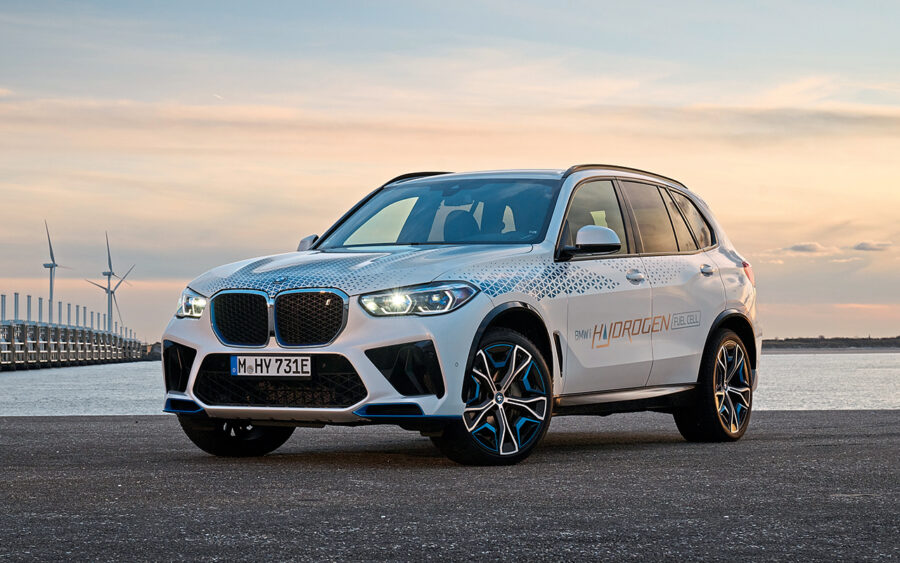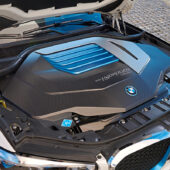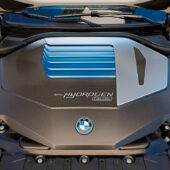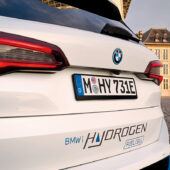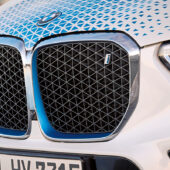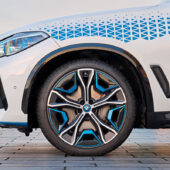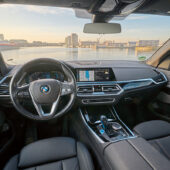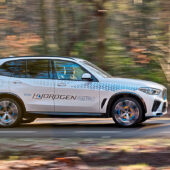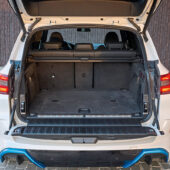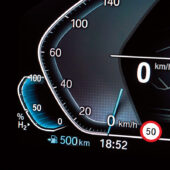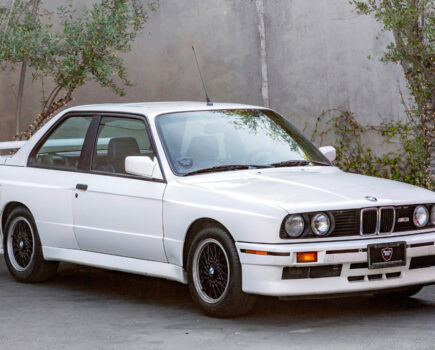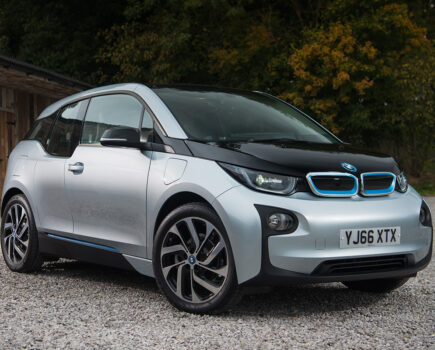BMW’s iX5 Hydrogen prototype won’t be available to buy any time soon, but it’s set to inform future decisions on hydrogen power
Words: James Fossdyke Images: BMW
Much has been made of hydrogen fuel cells and their potential for use in passenger cars. Or their lack thereof. It seems many people are divided by the prospect of fuel cells, which combine hydrogen and oxygen to create water and electricity, the latter of which powers an electric motor. The advantages are numerous – hydrogen is the most abundant element in the universe, filling up takes five minutes, and the only ‘tailpipe’ emission is water – but there are issues, too. For a kick-off, it’s less efficient than electric power, primarily because a battery-electric car simply stores existing electricity rather than creating it, but also because while hydrogen may be abundant, it’s difficult (and therefore energy-intensive) to produce.
As a result, some say hydrogen power is a distraction from the real end goal, which is pure electric power fed straight into the car’s battery. But BMW disagrees, claiming hydrogen power might be better suited to certain applications. Towing, long journeys and cold climates are all on BMW’s hit list, as are cars owned by people who simply don’t have easy access to reliable electric car charging. In short, they’re applications to which the X5 is generally well suited.
This is why BMW’s hydrogen test mule is an X5. More specifically, and in keeping with the brand’s electric nomenclature it’s the iX5 Hydrogen. In essence, it’s the X5 we know and love, but BMW has stuffed a hydrogen tank into the transmission tunnel and another under the back seats. Together, they hold up to 6kg of hydrogen, compressed to 700 bar. That feeds a stack of fuel cells, which are taken from the Toyota Mirai as part of BMW’s ongoing partnership with the massive Japanese manufacturer, and those, in turn, fuel a rear-mounted electric motor, which produces up to 401hp.
Not that you’d notice that from the outside, had BMW not helpfully plastered ‘Hydrogen’ stickers all over the bodywork. Ignore the livery, though, and the iX5 Hydrogen is pure X5. It even has a similar grille to the petrol and diesel versions because, unlike a pure electric car, the iX5 Hydrogen needs to ingest oxygen if it’s to turn that hydrogen into sweet, sweet electricity. Admittedly, BMW has fitted lots of blue accents to hammer home the car’s lack of carbon dioxide emissions, and there are no exhaust outlets poking through the rear valance, but otherwise, it could be any other X5.
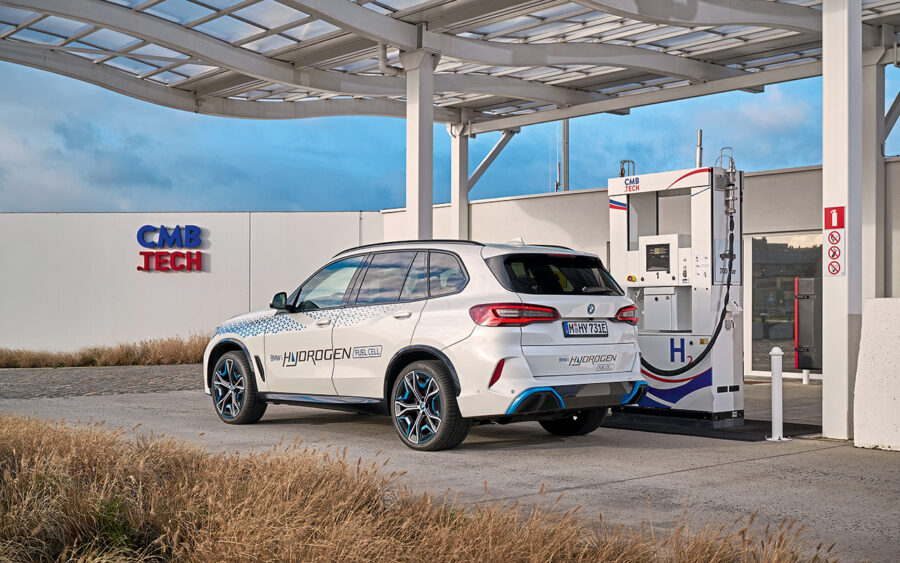
The interior is nigh-on identical to that of your common-or-garden X5, too, aside from the reappearance of the blue trim. Not only are there blue accents for the displays and a blue start button, but there’s more blue on the dash and the centre console. It’s a bit much, but then, it isn’t vastly more in-your-face than a 330e’s cabin. And although these cars are test mules, designed solely for internal use, they feel every bit as premium and as well built as a customer-bound X5. The leather is tactile, the build quality is first-rate, and the technology is largely clean and easy to use. Even the iDrive controller on the centre console is still in place, and although the digital instrument cluster is still a bit busy (and a bit blue), it’s every bit as useful as before. It has even been adapted to show your fuel consumption in miles per kilogram of hydrogen.
Interior space is just as good as before, too. BMW has managed to stow the hydrogen tanks in roughly the same space as the standard X5’s transmission and fuel tank, which means there’s no noticeable difference in interior capacity. There’s still plenty of space up front, and there’s ample room for two adults to sit across the back seats. You could get three in at a push, and all three would have enough headroom. Boot volume, meanwhile, is identical to that of the plug-in hybrid X5 xDrive45e, which means you get 500 litres of cargo space when the back seats are upright. Fold them down, and that expands to more than 1700 litres. That isn’t huge by big SUV standards – the basic X5 has a 650-litre boot with all five seats in place – but, it’s still on a par with a 3 Series Touring, and that’s hardly cramped.
Anyway, back to the powertrain lurking under the floor and a short physics and chemistry lesson for those uninitiated in fuel cell tech. The two high-pressure hydrogen tanks send hydrogen to the Toyota-derived fuel cells, where the world’s most abundant element reacts with oxygen from the ambient air to produce electricity and water (H²O). The electricity goes off to feed the electric motor and a small high-performance battery, which is always topped up. The battery allows the car to use its full 401hp output because the fuel cells can only provide enough juice to produce around 170hp at any one time.
However, the technology has its limitations. There are the difficulties in transporting and storing hydrogen and there are problems with producing it in volume because although it’s the most abundant element in the universe, it’s also very keen to latch on to other elements and much less keen to unstick itself. In short, producing it takes a lot of energy. All of this means some engineers reckon it’s more efficient to simply put that energy straight into a battery and send it to the car’s motor, reducing losses at various stages.
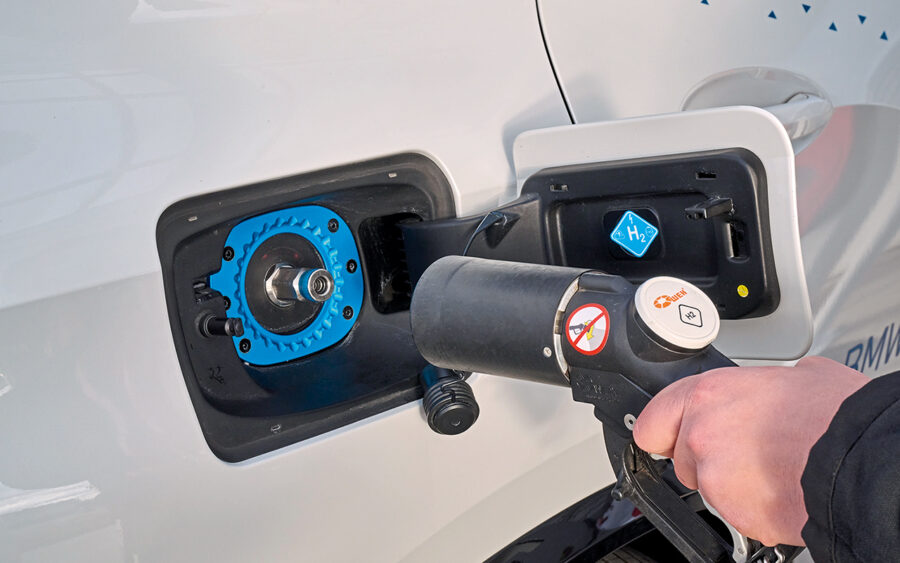
However, while BMW agrees that most cars should be battery electric, it also thinks hydrogen fuel cells still have a part to play, and the iX5 demonstrates why. That 6kg of hydrogen gives you enough power to travel 313 miles before refilling, which gives economy of around 50 miles per kilo of hydrogen. With a kilo of so-called ‘green’, low-carbon hydrogen – the stuff you need to make running a hydrogen car even remotely as ecological as a fully electric car – setting you back about £20 today, you’re talking about a price per mile that’s only slightly higher than that of an X5 M Competition. It isn’t cheap transport, but it isn’t too outrageous either.
Filling up with that fuel is a simple business that’s arguably easier than filling up with petrol, although you will need two hands. First, you open the filler flap, as you might in any other car, before removing the rubber cap over the filling nozzle. Then you’ll have to do the painful bit – paying up. At present, many hydrogen stations use RFID tags, as you might get with a charging membership, but credit and debit card payment is on the way. That bit done, you clip the hose to the filler nozzle until it clicks (some older pumps need you to lock the hose on with a lever) and press the green button on the pump. There’s no pistol grip to hold, and there’s nothing to do except listen to the pump go through its pressure checks and start delivering fuel. If you want to stop at any point, press the red button, otherwise it’ll keep going until the tank is full. Then you unclip it (this is the bit you need two hands for) and return the hose to the holster it came from. The entire process takes roughly the same time as filling with petrol.
Once that’s all done, our test drive suggested the 313-mile range would almost be achievable from day to day, particularly in traffic. Certainly, you’re talking about more than 200 miles on a tank, and while that looks expensive in today’s money, you have to remember you can’t buy a hydrogen-powered X5 yet. Before BMW enters the market properly, the infrastructure will have to be in place, and the first hydrogen trucks will have to be on the road, taking advantage of the short filling times and the long-range provided by the fuel cells. Given haulage companies are unlikely to stomach £20 a kilo for fuel, the price of hydrogen will likely have fallen by that point.
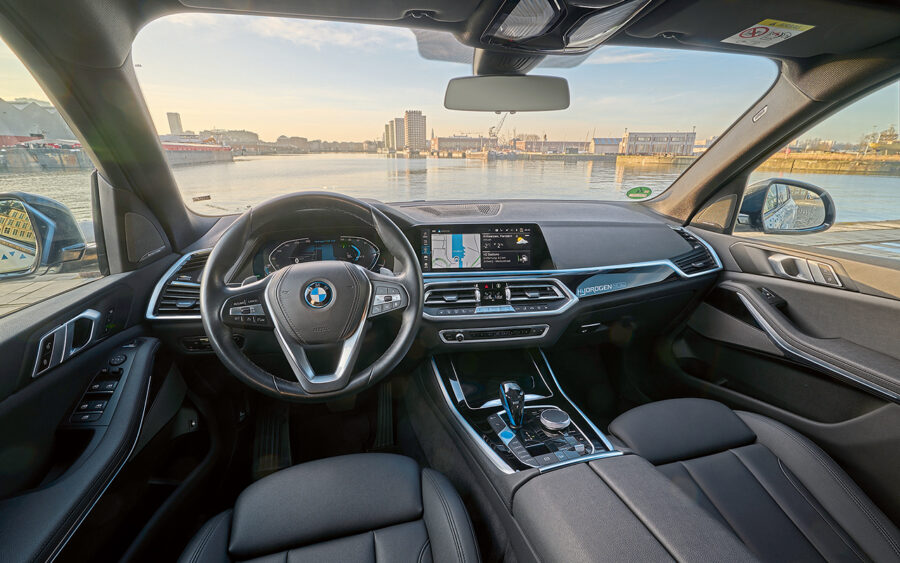
Hydrogen has other advantages over battery-electric power, too, including an insouciance to cold weather and a reduction in the number of rare metals used to build the car in the first place.
But when you drive the iX5 Hydrogen, it feels exactly as you expect an electric X5 to feel. Not that such a thing exists. What we mean by that is it’s smooth, it’s quiet, and it’s refined. It’s comfortable, too, thanks to its air suspension, although the weight of around 2.5 tonnes means the ride is a little brittle over certain bumps. Generally speaking, though, the X5 has all the attributes you expect.
And it’s potent. While 401hp isn’t all that much compared with an X5 M Competition, the instant shove in the back you get from an electric motor means it feels faster than its six-second 0-62mph time would suggest. Overtaking is easy, nipping around in traffic is even easier, and it does it all with very little noise whatsoever. There’s a little bit of tyre roar and wind noise, which is perhaps to be expected, and that’s it.
What’s more, the iX5 Hydrogen still drives like an X5 should. BMW hasn’t set this car up to be particularly sporty, but it still hangs on well in corners, and the steering feel is just as good as that of the standard X5. There’s a bit of body roll, of course – even the air suspension can’t combat the laws of physics to that extent – but it’s relatively well-controlled, and it’s much better than in some big SUVs. However, the fuel cell car doesn’t seem to have the rigidity or the low centre of gravity you get from an electric SUV.
The top speed is limited to around 112mph, which isn’t especially exciting. In fact, it’s a bit slow for a German SUV which is designed to deal with the demands of the derestricted autobahns. Nevertheless, whatever your thoughts on the usefulness of hydrogen in passenger cars may be, it’s hard to deny the customer appeal of a fuel cell-powered X5. The 313-mile range is an instant boon, as is the prospect of a five-minute refill. Of course, you can achieve all this with a petrol-powered X5, but as great as those cars may be, they aren’t as refined as the iX5 Hydrogen and they emit considerably more environmentally damaging substances from the rear.

Naturally, there are obstacles. The number of hydrogen filling stations in the UK has barely reached double figures, and the fuel itself isn’t cheap (or necessarily very green), but these are infrastructure issues rather than problems with the car itself. Yet the iX5 Hydrogen will never go on sale in this form, partly because the infrastructure still isn’t there yet, and we hate to think how much it would cost, but there are definitely situations in which the hydrogen powertrain will one day make sense. Even if it isn’t as efficient as electric power or as cheap to consume, it has the potential to be more versatile for the end user. And in markets such as Japan, where hydrogen filling stations are becoming increasingly numerous, that time is not too far away.
Even there, though, the anti-hydrogen lobby will probably want its say. But no powertrain will ever be perfect, and the secret will always be to choose the best propulsion system for a given circumstance, regardless of what that might be. With current tech, it seems battery-electric power will remain the best choice for many, but it won’t suit everyone everywhere. In short, we need choice, and if nothing else, the iX5 Hydrogen is a welcome reminder that manufacturers are still considering all their – and our – options. It also shows us that no matter what kind of powertrain BMW puts under the bonnet, the firm can still make brilliant cars.

